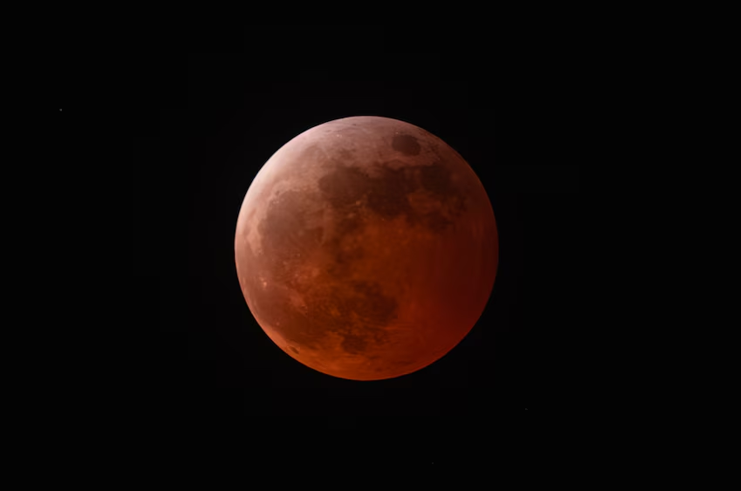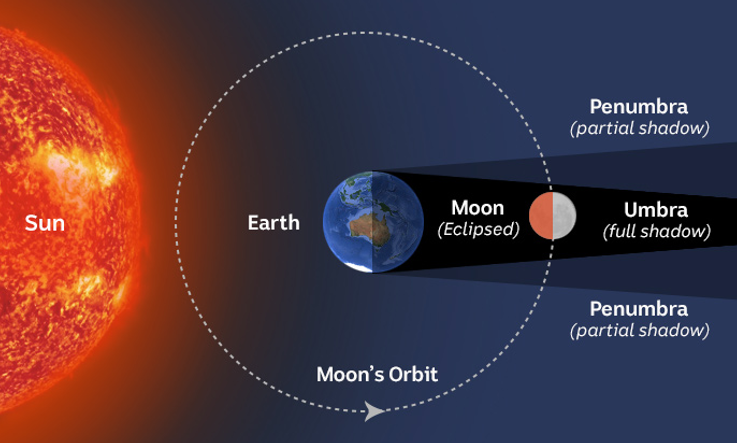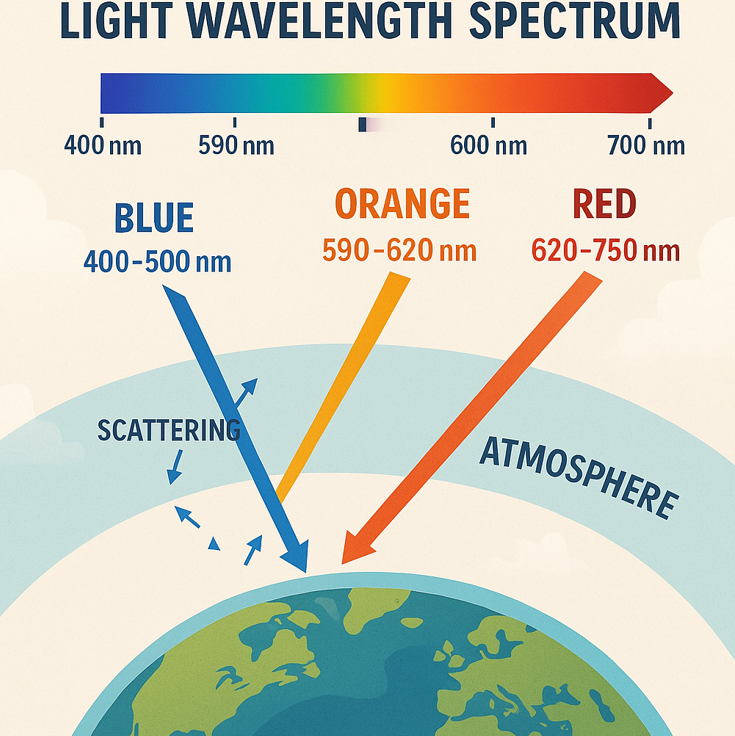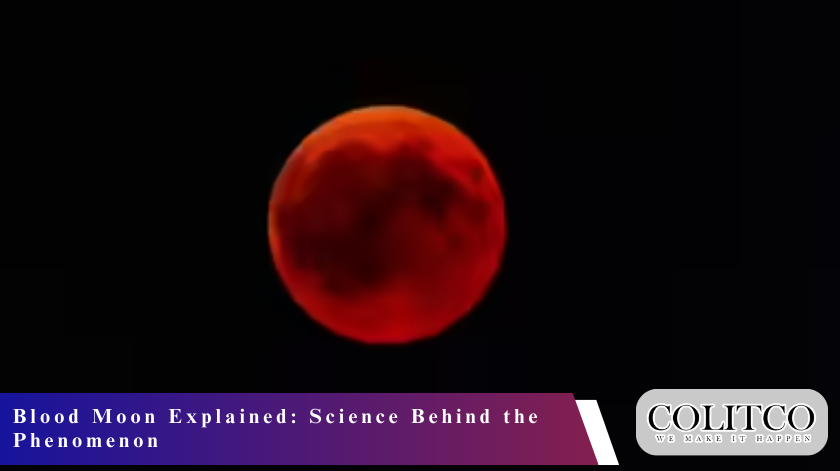Understanding the Blood Moon
A blood moon occurs during a total lunar eclipse when the Earth moves directly between the Sun and the Moon. The alignment causes the Earth’s shadow to cover the Moon and creates a striking red appearance. Unlike ordinary full moons, a blood moon emerges only when the Sun, Earth, and Moon align perfectly.
The Moon does not emit its own light but reflects sunlight. During a lunar eclipse, sunlight passes through Earth’s atmosphere before reaching the Moon. Only specific wavelengths of light, mainly red, reach the lunar surface. This scattering process makes the Moon appear copper or deep red to observers on Earth.

Figure 1: A Blood Moon
The Science of Lunar Eclipses
Lunar eclipses happen between two and four times every year. However, total lunar eclipses, which produce a blood moon, remain less frequent. Astronomers calculate that such events occur roughly every one to three years globally.
The phenomenon relies on Rayleigh scattering, the same effect that makes sunsets appear red. Earth’s atmosphere filters blue and green light while bending the red spectrum into its shadow. The Moon receives this refracted light, producing the red glow.
The duration of a blood moon varies depending on Earth’s position in relation to the Sun and Moon. A total eclipse can last over an hour, while partial eclipses last much shorter. These events hold importance for astronomers because they allow detailed study of Earth’s atmosphere through the refracted light spectrum.

Figure 2: The alignment of Earth, Sun, and Moon during a lunar eclipse
Historical and Cultural Significance
Blood moons have been observed for centuries and recorded in many cultures. Ancient civilisations often attached symbolic meaning to red moons. In early societies across Asia, Europe, and the Americas, a blood moon often represented warnings or celestial events of significance.
Religious and cultural traditions frequently referenced red moons as omens. Despite these interpretations, modern astronomy explains every detail through scientific observation. Documented eclipses have also served as important references for dating historical events. For instance, historians have used accounts of lunar eclipses to align records with specific timeframes, offering valuable insights into human history.
Global Frequency of Blood Moons
On average, there are two lunar eclipses every year visible from different parts of the world. Not every eclipse results in a visible blood moon as partial shadows often occur. Total lunar eclipses producing a striking red Moon take place less often though they remain predictable through astronomical calculations.
The last century recorded 229 lunar eclipses, with 87 of them categorised as total eclipses. Scientists use these occurrences to strengthen models of celestial cycles and orbital motion. Global communities usually anticipate these events well in advance due to high accuracy in astronomical predictions.
Observation of the Phenomenon
A blood moon attracts global attention due to its scale and visibility. Unlike solar eclipses, lunar eclipses can be safely observed without protective equipment. Observers require clear weather conditions and an unobstructed view of the night sky.
Astronomical societies and space agencies often provide live streams during notable total lunar eclipses for viewers unable to witness the event directly. Large populations across Asia, Australia, Europe, and the Americas regularly gather outdoors to witness the spectacle.
Telescopes and digital cameras capture highly detailed images, while scientists measure atmospheric changes from the refracted light. Instruments detect particles and gases affecting the atmosphere, extending knowledge about Earth’s environmental conditions.
Distinguishing Blood Moons from Other Lunar Events
The blood moon differs from other lunar appearances, including supermoons and blue moons. A supermoon occurs when the Moon’s orbit brings it closest to Earth, creating a brighter and larger appearance. A blue moon refers to the second full moon in a calendar month. Neither displays the red colour produced during a total eclipse.
Blood moons remain significant because they illustrate Earth’s atmospheric effects on light with clarity across the lunar surface. Astronomers emphasise that the event shows a direct interaction between terrestrial and cosmic conditions.

Figure 3: Light Wavelength Filtering Process
Scientific Insights from Blood Moons
Scientists benefit from eclipses by collecting data otherwise unavailable. Spectroscopic analysis of atmospheric light during blood moons helps identify pollution levels, volcanic activity, and global temperature shifts. The refracted sunlight carries data about atmospheric dust and chemical compositions that remain difficult to collect through ground-based instruments.
Research linked to major volcanic eruptions shows that particles expelled into the atmosphere altered blood moon appearances. For instance, after the 1991 eruption of Mount Pinatubo, eclipses displayed darker tones as ash blocked sunlight. Such variations demonstrate how celestial events can reveal Earth’s environmental changes.
Also Read: Rare Blood Moon Set to Illuminate UK Skies During September Lunar Eclipse
Anticipated Blood Moons
Astronomical calendars mark future lunar eclipses well ahead of time. The frequency remains regular, allowing prediction of visibility patterns across regions. Observers in Australia, Asia, and the Americas can expect several total lunar eclipses within the next decade.
Astronomers highlight these events as opportunities for public engagement and scientific work. Educational institutions frequently organise viewing programs while research organisations maximise data collection from the rare alignments. Global collaboration during these events underlines their importance beyond specific borders.
Conclusion
A blood moon reflects natural processes shaped by cosmic geometry and atmospheric science. The Moon’s red glow results from refracted light influenced by Earth’s air and pollution levels. For generations, humans interpreted the event through culture and symbolism, yet scientific advances identified the physical causes clearly.
Today, blood moons continue to encourage interest in astronomy while enabling key environmental studies. They connect scientific research with public fascination, bridging history and modern analysis. The phenomenon remains a rare reminder of Earth’s position within larger celestial cycles.
Five Most Frequently Asked Questions About Blood Moons
- What is a blood moon and why does it turn red?
This fundamental question appears most frequently as people want to understand the basic phenomenon. The answer involves explaining how Earth’s shadow during a total lunar eclipse causes the red appearance through atmospheric light filtering and Rayleigh scattering.
- How often do blood moons occur and when is the next one?
People consistently ask about frequency and timing for viewing opportunities. Blood moons happen during total lunar eclipses, which occur approximately twice yearly globally, though not every location sees each event. The next blood moon will be visible on 7 September 2025.
- How long does a blood moon last?
Duration questions appear regularly in FAQ sections. The totality phase when the Moon appears fully red typically lasts between 30 minutes to over an hour, with the entire eclipse process spanning several hours.
- Where can you see a blood moon and do you need special equipment?
Visibility and observation methods generate frequent inquiries. Unlike solar eclipses, blood moons can be safely viewed with naked eyes from any location where the Moon is visible during the eclipse.
- Is a blood moon dangerous or does it have special meaning?
Cultural significance and safety concerns appear consistently across sources. While historically viewed as omens in various cultures, blood moons are natural astronomical events with no physical effects on Earth or human behaviour.












